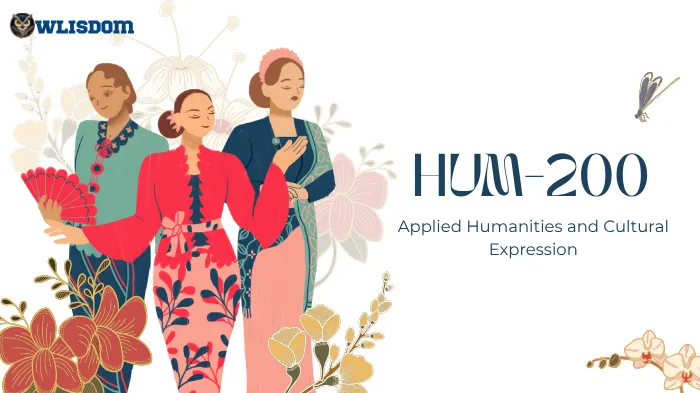HUM-200 – Applied Humanities and Cultural Expression: Understanding Cultural Perspectives, Creative Expression, and Ethical Decision-Making
Published: 2025-10-09
Modified: 2025-10-09
Samples Solutions
Introduction:
HUM-200 – Applied Humanities and Cultural Expression explores how creativity, ethics, and cultural understanding influence human experiences. The course encourages students to connect ideas from literature, philosophy, and the arts to modern-day challenges. For expert support with essays or reflective writing, visit Owlisdom’s Humanities Essay Help.
HUM 200 1-1 Discussion: Learning to Analyze the Humanities
Instructions for HUM 200 1-1 Discussion
Analyze the Humanities
In the first part of your discussion post, introduce yourself to your classmates. Where are you from? What is your major, and what do you hope to learn from this course? Next, discuss which of the three focal points of Module One (visual art, literature, or music) you are most comfortable with. Which do you have the most experience with, and which do you find the most challenging to understand? Include specific examples to support your response. Also, if you have a question for the other students, feel free to include it as part of your response.
You can title your thread any way you choose.
In response to your peers, choose a different focal point than the one you chose for yourself, and elaborate on how your peers’ choice of focal point could be relevant to you. What do you think you could learn from these students’ perspectives?
For additional details, please refer to the Discussion Rubric PDF document.
Introduction to HUM 200 1-1 Discussion
Welcome to the HUM 200 1-1 Discussion: Learning to Analyze the Humanities. This discussion post revolves around your understanding of and learning how to analyse humanities. I will provide brief and descriptive guidelines to solve the 1-1 Discussion post and a dummy solution for each section. This How-To Owlisdom Guide will equip you with guidelines to tackle all the queries related to the HUM 200 1-1 Discussion: Learning to Analyze the Humanities. Let us begin with the guide.
Introduce yourself to your classmates. Where are you from, what is your major, and What do you hope to learn from this course?
Introduction
We will introduce ourselves and provide brief expectations for the HUM 200 course.
- Introducing Yourself: Start with a friendly greeting. Share your name, where you are from, and a fun fact or hobby to make your introduction memorable.
- Discussing Your Major: Briefly explain why you chose it and how it relates to your career goals.
- Expressing Course Expectations: Mention what you hope to learn in this course and how it might help you in your academic or professional journey.
Example
Hello everyone! I am Alex from sunny California, and when I am not buried in books, I love to explore the world through my camera lens. I am majoring in Applied Humanities with a focus on cultural studies because I am fascinated by how cultures intersect and influence each other. My goal is to work in cultural preservation, helping to maintain and share the rich tapestry of global heritage. From this HUM 200 course, I am eager to deepen my understanding of how art, literature, and music reflect and shape societal values. I hope to apply these insights to my future projects in cultural preservation.
Discuss which of the three focal points of Module One (visual art, literature, or music) you are most comfortable with. Which do you have the most experience with, and which do you find the most challenging to understand?
Discussing Comfort with Focal Points
In this section of the 1-1 Discussion, we will explore focal points and our comfort with those focal points.
- Identifying Your Comfortable Focal Point: Pick the focal point (visual art, literature, or music) you feel most at ease with. Explain why this is your comfort zone.
- Explaining Your Experience: Share any personal experiences that contributed to your familiarity with this focal point. This could include classes, hobbies, or events.
- Identifying Challenges: Mention which focal point you find most challenging and why. Be honest but optimistic about learning more about it.
Example
I have always been most comfortable with literature. Something about the power of words and the worlds they can create has always resonated with me. Growing up, I was the kid who would stay up late, flashlight in hand, devouring every book I could find. My experience with literature spans countless genres, from classic novels to contemporary poetry, shaping my imagination and perspective on life. Music, however, presents a challenge for me. Despite enjoying it, I struggle to understand its technical aspects and the theory behind compositions. I am eager to dive deeper into music in this course, hoping to appreciate it better and understand its impact.
Include specific examples to support your response.
Including Specific Examples
We will provide specific examples for this 1-1 Discussion section.
- Using Examples for Visual Art: If visual art is your focus, mention a favourite artist or art piece and why it resonates with you.
- Employing Examples from Literature: For literature, reference a book, author, or genre you enjoy and discuss its impact on you.
- Incorporating Music Examples: If music is your choice, talk about a genre, artist, or specific piece of music that you love and the reasons for your preference.
Example
Diving deeper into my affinity for literature, one book that stands out is “To Kill a Mockingbird” by Harper Lee. Beyond its narrative, this novel taught me the complexities of human nature, justice, and empathy from a young age. It is a prime example of how literature can influence one’s ethical and moral compass. As for music, my challenge lies in understanding the intricacies behind compositions. However, I am drawn to the emotional depth of classical music, particularly to compositions like Beethoven’s “Moonlight Sonata,” which, despite my limited technical understanding, profoundly moves me with its sad melody and intricate emotionality.
You can title your thread any way you choose.
Titling Your Thread
Now, we will give the title of our thread to the 1-1 Discussion post.
- Choose a creative title that reflects your main points or focal points.
- Make it engaging to encourage classmates to read and respond.
Example
“Between the Lines and Beyond the Notes: A Journey Through Literature and Music”
This title encapsulates my deep-seated love for literature, highlighted by the profound impact “To Kill a Mockingbird” has had on my understanding of humanity and my budding curiosity toward the emotional depths of classical music, exemplified by Beethoven’s “Moonlight Sonata.” It invites a conversation on the transformative power of words and the emotive resonance of music, encouraging classmates to explore and share their experiences with these diverse yet equally compelling forms of expression.
In response to your peers, choose a different focal point than the one you chose for yourself, and elaborate on how your peers’ choice of focal point could be relevant to you. What do you think you could learn from these students’ perspectives?
Peer Responses
1-1 Discussion requires at least two peer responses. I will provide an example of a response along with the guidelines for writing responses.
- Choosing a Different Focal Point: When replying, select a focal point different from yours. Briefly mention why you chose to respond to this focal point.
- Elaborating on Relevance: Discuss how your peer’s focal point could be relevant to you. Maybe it offers a new perspective or complements your interests.
- Learning from Peers: Mention one thing you could learn from their perspective. Keep your response concise and focused on mutual learning.
Example
I was intrigued by your focus on visual art, mainly since my comfort zone lies within literature. Your mention of Van Gogh’s “Starry Night” piqued my interest, offering a perspective on how emotions and ideas can be conveyed through words and visually, painting a picture that speaks volumes without a single spoken word. This cross-disciplinary understanding could enrich my appreciation for storytelling, showing me how narratives can be woven through colours, strokes, sentences, and paragraphs. I am keen to learn how visual art can complement literary themes, possibly enhancing my interpretations of literature.
Closing
This How-To Owlisdom Guide is designed to make your engagement in applied humanities as enriching and enjoyable as possible. Following these instructions, you can effectively introduce yourself, discuss your interests and challenges, and foster meaningful discussions with your peers. Remember, the goal is to learn from each other and explore the humanities collaboratively. I hope you ace the HUM 200 1-1 Discussion: Learning to Analyze the Humanities. Good luck!
HUM 200 2-1 Discussion: Overcoming Challenges
Instructions for HUM 200 2-1 Discussion
In your discussion post, describe what has been challenging about getting through the course thus far, and explain what has helped you overcome that challenge. If you have a question for the other students, feel free to include it as part of your response.
In response to your peers ' comments on the challenges they describe, provide an additional suggestion to help them overcome the obstacles they face.
For additional details, please refer to the Discussion Rubric PDF document.
Introduction to HUM 200 2-1 Discussion
This discussion post revolves around your understanding of overcoming challenges you have faced during HUM 200. I will provide brief and descriptive guidelines to solve the 2-1 Discussion post and a dummy solution for each section. This How-To Owlisdom Guide will equip you with guidelines to tackle all the queries related to the 2-1 Discussion post. Let us begin with the guide.
In your discussion post, describe what has been challenging about completing the course thus far, and explain what has helped you overcome that challenge. If you have a question for the other students, please include it in your response.
Identifying Challenges
We will discuss our challenges to start the HUM 200 2-1 Discussion: Overcoming Challenges.
- Personal Challenges: Reflect on any personal barriers you’ve encountered while progressing through the course. This could include time management issues, maintaining motivation, or balancing coursework with other responsibilities.
- Be honest and specific about your experiences, but maintain a positive tone.
- Academic Challenges: Discuss any academic difficulties you’ve faced, such as understanding specific concepts or managing coursework load.
Example
Personal Challenges
Balancing my coursework with a part-time job has been my biggest personal challenge. Juggling deadlines and shifts often left me overwhelmed. However, setting strict study hours and prioritizing tasks based on urgency and importance significantly eased the pressure. Embracing flexibility within my structured schedule allowed me to maintain motivation and keep up with both responsibilities.
Academic Challenges
Grasping complex theories was daunting, particularly when they contradicted my preconceived notions. The sheer volume of reading materials also proved challenging. Participating in study groups and discussing these theories in forums helped me tremendously. Not only did it aid my understanding, but it also exposed me to different perspectives, enriching my learning experience.
Overcoming Challenges
- Strategies and Solutions: Share your strategies to address the challenges mentioned. This might include creating a study schedule, utilizing additional resources, or engaging in study groups.
- Emphasize the effectiveness of these strategies in improving your course experience.
Example
Creating a detailed study schedule and sticking to it has been pivotal in managing personal and academic challenges. Allocating specific times for coursework, job responsibilities, and self-care created a balanced routine. Engaging with peers through study groups clarified difficult concepts and provided moral support. These strategies have not only improved my course performance but also enhanced my overall well-being.
In response to your peers ' comments on the challenges they describe, provide an additional suggestion to help them overcome the obstacles they face.
Responding to Peers
When replying to peers, your response should be concise and supportive.
- Start by acknowledging the challenges your peer has shared. Show empathy and understanding, indicating that their feelings and difficulties are valid.
- Offer a practical suggestion based on your experience or insights that could help your peer address their challenge.
- Keep your advice specific but brief, ensuring it’s actionable and directly relevant to the issue discussed.
Response 01
I understand how managing time between work and studies can be overwhelming. One trick that helped me was using a digital planner app to set reminders for my work shifts and study sessions. It’s a great way to organize your week and find balance visually. Give it a try; it might ease that overwhelming feeling.
Closing
Following these guidelines, you can solve the HUM 200 2-1 Discussion: Overcoming Challenges post like a pro.
HUM 200 2-6 Project Part One: Artifacts and Theme Selection
Instructions of HUM 200 2-6 Project Part One
To submit Project Part One: Artifacts and Theme Selection, upload the polished version of the document you downloaded from Soomo to the Attachments link for instructor grading and feedback.
For additional details, please refer to the Project Part One Artifacts and Theme Selection Guidelines and Rubric PDF document.
Step-By-Step Guide HUM 200 2-6 Project Part One: Artifacts and Theme Selection
Introduction to HUM 200 2-6 Project Part One
In the HUM 200 2-6 Project Part One: Artifacts and Theme Selection, you will embark on a comparative analysis of two distinct cultural artifacts linked through a common theme. The aim is to understand how specific themes persist and manifest differently across time and artistic mediums. This How-To Owlisdom Guide will help enhance your appreciation of the humanities and deepen your insight into personal experiences that resonate with these themes.
Choose two cultural artifacts to analyze. These artifacts may take the form of any artistic medium, such as literature, poetry, music, film, dance, painting, sculpture, etc. However, choosing two artifacts created by different artists and created during other periods (ex., separated by at least 50 years) is essential.
Choosing Your Artifacts
To start the HUM 200 2-6 Project Part One: Artifacts and Theme Selection, we will choose two cultural artifacts to analyze.
- Diversity in Creation: Ensure the artifacts are from different artistic forms (like literature and painting), created by other artists, and originate from distinct periods (at least 50 years apart).
- Availability of Information: Choose artifacts with accessible historical data and critical analyses to support your research.
Example
For my project, I have selected two significant American cultural artifacts that embody the theme of the American Dream, created over fifty years apart, highlighting its evolving perception through time.
The first artifact is the novel The Great Gatsby by F. Scott Fitzgerald, published in 1925 (Britannica, 2024). This literary work delves into the complexities of the American Dream during the Roaring Twenties, capturing the era’s opulence, disillusionment, and stark inequalities. Fitzgerald’s narrative revolves around the life and ambitions of Jay Gatsby, a man whose relentless pursuit of wealth and status mirrors the societal obsession with material success.
The second artifact is the film Forrest Gump, directed by Robert Zemeckis and released in 1994 (Britannica, 2024). Unlike The Great Gatsby, Forrest Gump presents a more optimistic and resilient view of the American Dream. Through the protagonist’s journey across historical American moments, the film explores themes of destiny, innocence, and the possibility of achieving greatness regardless of background. These artifacts represent distinct artistic media and offer contrasting perspectives on a central theme pivotal to American culture, providing a rich basis for comparative analysis.
Describe the cultural artifacts that you have chosen. Consider questions such as these in your response: What is the name or title of the artifact? Who is the author or artist? What is the date or period when the artifact was created? What is the cultural location or physical setting of the artifact? In addition, you could consider including a photograph or image of each cultural artifact if they are visual artifacts.
Describing the Artifacts
Next, we will describe the selected artifacts.
- Basic Details: Include the name, creator, date, and cultural or physical setting of each artifact.
- Contextual Background: Briefly describe each artifact’s creation’s historical and cultural context.
- Incorporating Images: Include images of the artifacts to provide a visual reference to enhance your textual analysis.
Example
The Great Gatsby, written by F. Scott Fitzgerald, was published in 1925. It is set in the prosperous Roaring Twenties on Long Island and New York City, reflecting the era’s decadence and the disillusionment following World War I. The novel explores themes of the American Dream, class struggle, and the pursuit of happiness, capturing the spirit and challenges of its time.
Forrest Gump, released in 1994 and directed by Robert Zemeckis, spans several decades, following the titular character from the 1950s through the late 20th century in the United States. The film uses critical historical events to frame Forrest’s journey, providing a backdrop that explores themes of destiny, innocence, and the impact of the individual on a changing American society.
Both artifacts stand as cultural icons within their respective periods and offer rich narratives that engage with fundamental American ideals and societal reflections.
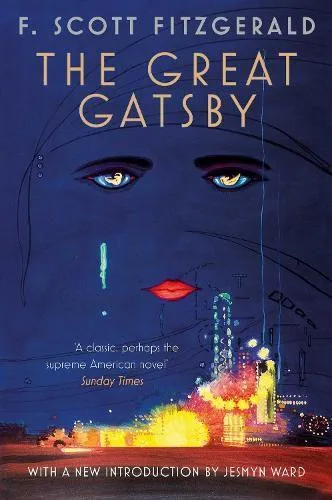
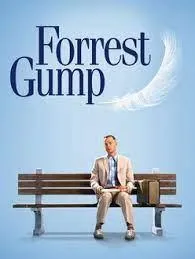
Identify at least one common theme that will serve as the framework of your exploration document. How is the theme expressed in your artifacts?
Identifying the Theme
For this HUM 200 Part One section, we will identify a common theme in the selected artifacts.
- Thematic Exploration: Identify themes expressed in both artifacts. This could range from abstract concepts like freedom or justice to more concrete themes like the impact of technology on society.
- Artistic Manifestation: Describe how each artifact represents the identified theme, focusing on symbolism, narrative style, or artistic techniques.
Example
In analyzing The Great Gatsby and Forrest Gump, a common theme is the pursuit of the American Dream. This theme is intricately woven through the narrative arcs and character developments within both artifacts, albeit presented with distinct perspectives reflective of their different historical contexts.
In The Great Gatsby, the American Dream is explored through Jay Gatsby’s relentless pursuit of wealth and social status, which he believes are essential for reclaiming his lost love, Daisy Buchanan. Fitzgerald employs symbolism extensively, such as Gatsby’s opulent parties and his elusive green light at the end of Daisy’s dock, to depict the dream’s hollowness and, ultimately, unattainability. The novel portrays the dream as corrupted by materialism and the socio-economic realities of 1920s America, illustrating the disillusionment felt by many during the era.
Contrastingly, Forrest Gump presents a more optimistic depiction of the American Dream. Forrest, a man with a low IQ, inadvertently influences significant cultural and historical events in America, achieving personal and financial success despite his limitations. The narrative style, combining humor and pathos, along with the film’s use of historical footage, underscores the idea that the American Dream is accessible to all, regardless of one’s background or abilities. The film suggests that integrity and perseverance are crucial to realizing the dream, presenting a redemptive perspective on American values.
Thus, both artifacts offer rich, albeit contrasting, explorations of the American Dream, providing a multifaceted understanding of this enduring theme within American culture.
Reflect on how the theme you identified is related to your personal experience. For instance, you could discuss how the expression of the theme in your cultural artifacts is connected to you personally.
Personal Connection
This section of HUM 200 2-6 Project Part One: Artifacts and Theme Selection will relate the identified theme to our personal experiences.
- Personal Resonance: Discuss how the theme relates to your life experiences or values. This reflection will help personalize your analysis and potentially reveal more profound insights into the theme.
- Connecting the Dots: Draw connections between your personal experiences and the thematic expression in the artifacts to illustrate the theme’s broader relevance.
Example
Reflecting on the theme of the American Dream as portrayed in The Great Gatsby and Forrest Gump, I find a personal connection to the narratives of aspiration and the varied outcomes of pursuing one’s dreams. The theme resonates with my life through my family’s history and experiences, echoing the broader narrative of seeking success and fulfillment in America.
Much like that of Forrest Gump, my family’s journey is characterized by humble beginnings and the belief that hard work and integrity can lead to achieving one’s dreams, regardless of initial disadvantages; my grandparents migrated to the United States with little to their names, driven by the hope of a better life. Their stories, filled with challenges and triumphs, mirror Forrest’s serendipitous journey through American history, where his straightforward and honest approach to life brings him unexpected success.
On the other hand, The Great Gatsby reflects the more exemplary aspects of the American Dream. (LACEB, 2018) I have observed how ambition can become tainted by materialism and how pursuing an idealized goal can lead to disillusionment. In my community, I have seen many who, like Gatsby, strive for what they perceive as the pinnacle of success, often losing sight of their original values and relationships along the way.
These artifacts highlight the dual nature of the American Dream, and in studying them, I’ve gained a deeper understanding of its complexities and contradictions. This theme’s exploration helps contextualize my family’s experiences within the broader narrative of American aspiration and caution, enriching my perspective on what it truly means to achieve the American Dream.
Closing
The HUM 200 2-6 Project Part One: Artifacts and Theme Selection prompts you to engage deeply with cultural artifacts, encouraging a nuanced understanding of how themes are woven through the human experience across time and media. By analyzing these artifacts and reflecting on your connections to the themes, you enrich your understanding of the humanities and discover more about your interpretive and emotional responses to art. HUM 200 2-6 Project Part One: Artifacts and Theme Selection is a valuable step in appreciating the interconnectedness of art, history, and personal experience in the broader tapestry of human culture.
References
Britannica. (2024, March 4). Nick Carraway | fictional character | Britannica. https://www.britannica.com/topic/Nick-Carraway
Britannica. (2024, April 3). Forrest Gump | Plot, Cast, Awards, & Facts | Britannica. https://www.britannica.com/topic/Forrest-Gump
LACEB, R. (2018). F. Scott Fitzgerald’s The Great Gatsby (1925): Variations on Forms and Themes. Université Mouloud Mammeri.
HUM 200 4-1 Discussion: Humanities and Other Disciplines
Instructions for HUM 200 4-1 Discussion
Up until this point in the course, you’ve explored the process of analyzing works from the humanities. You’ve also started researching specific works for your project.
Compared to what you know about the methods of disciplines such as mathematics, the natural sciences (e.g., biology, chemistry), or the social sciences (e.g., psychology, sociology), what do you think is unique about the methods used to investigate the humanities? If you have any questions for your peers, feel free to include them as part of your response.
In response to your peers, explain whether you agree or disagree with their conclusions, and explain why.
For additional details, please refer to the Discussion Rubric PDF document.
Introduction to HUM 200 4-1 Discussion
This discussion post revolves around your understanding of Humanities and Other Disciplines. I will provide brief and descriptive guidelines to solve the HUM 200 4-1 Discussion: Humanities and Other Disciplines, and a dummy solution for each section. This How-To Owlisdom Guide will equip you with guidelines to tackle all the queries related to the 4-1 discussion post. Let us begin with the guide.
Compared to what you know about the methods of disciplines such as mathematics, the natural sciences (e.g., biology, chemistry), or the social sciences (e.g., psychology, sociology), what do you think is unique about the methods used to investigate the humanities? If you have any questions for your peers, please include them in your response.
Comparison with Other Disciplines
To start the HUM 200 4-1 Discussion: Humanities and Other Disciplines, we will compare the field of Humanities with other disciplines.
- Identify Key Methods: List the methods you’ve learned in humanities, such as textual analysis, hermeneutics, or critical theory. Then, these will be contrasted with techniques from other disciplines, such as empirical experiments in natural sciences or statistical analysis in social sciences.
- Focus on Differences: Highlight how humanities research often focuses on interpretation and meaning, unlike the empirical data-driven approaches in the sciences. Discuss how this difference influences the type of questions asked and the conclusions drawn.
Example
As a student delving into the humanities, I’ve noticed our methods significantly differ from those in disciplines like mathematics, natural sciences, and social sciences. In the humanities, we heavily rely on textual analysis, hermeneutics, and critical theory. These methods prioritise understanding texts’ and artefacts’ underlying meanings, cultural contexts, and philosophical implications. This contrasts sharply with the empirical experiments and statistical analyses prevalent in natural and social sciences, where concrete data and measurable outcomes are king.
One unique aspect of humanities research is its interpretative nature. While sciences seek definitive answers through data, the humanities embrace subjectivity, often leading to multiple valid interpretations of the same work. This interpretative approach allows for a deeper exploration of human experiences, cultures, and values, which are not easily quantifiable.
Identifying Unique Aspect
Next, we will analyse the unique aspects of different disciplines concerning the Humanities.
- Emphasise Interpretation: Human research involves interpretation, subjectivity, and contextuality. Explain how these aspects allow for diverse perspectives on the same work.
- Illustrate with Examples: Use examples from your project or studies to illustrate these unique aspects. This will make your analysis more concrete and relatable.
Example
Our focus on interpretation, subjectivity, and contextuality in the humanities sets us apart from more data-driven disciplines. These aspects foster a rich tapestry of perspectives on the same work. For instance, in my study of Shakespeare’s “Hamlet,” the interpretation of the protagonist’s motives can vary widely. Some view Hamlet as a hero grappling with existential dilemmas, while others see him as paralysed by indecision. This subjectivity, rooted in personal and cultural contexts, allows us to explore the depth of human experience, showing how the same text can evoke diverse understandings based on the viewer’s unique perspective.
In response to your peers, explain whether you agree or disagree with their conclusions, and explain why.
Peer Responses
Responding to peers is one of the vital parts of the HUM 200 discussion posts. We need to provide at least two peer responses. I will provide one example post. You can write your peer responses by keeping the following points in mind.
- Engage with Curiosity: Draft questions that reflect your genuine curiosity about the nuances of humanities research. Ask about their experiences or perspectives on the interpretative nature of the humanities compared to the empirical focus of other disciplines.
- Encourage Discussion: Phrase your questions to encourage open-ended responses. Avoid yes/no questions to foster more meaningful exchanges.
Example
I agree with your insights on the unique interpretative nature of humanities research. It’s fascinating how our discipline allows various perspectives on the same works. Your example of “Hamlet” perfectly illustrates this point.
HUM 200 4-4 Project Part One: Rough Draft
Instructions for HUM 200 4-4 Project Part One
Discuss a profession that could be impacted by the theme you identified. In other words, how is the theme you
identified related to professional
experiences? How could a working knowledge of the humanities be useful in
this field?
Describe at least three humanities resources that you could use to investigate your theme and artifacts. Your sources
must be relevant to your theme
and of an appropriate academic nature. In your description, consider questions
such as the following: What are the similarities and differences in the
content of your sources?
What makes them appropriate and relevant for investigating your issue? What was your thought process when you
were
searching for sources?
How did you make choices? Did you encounter any obstacles and if so, how did you overcome them? If you did not, why
do you
Think it was so easy to find what you needed?
Use the humanities resources that you selected to research your theme and cultural artifacts, making sure that you
cite your sources. Based on your
Research, do the following:
A. Discuss the relationship between each
cultural artifact and its historical context. In other words, what were the circumstances under which
each
Artifact was created?
B. Explain the similarities and differences that you observe in the cultural
artifacts you selected, in relation to the theme. For instance, do the
Do artifacts contain any symbolism? If
so, how are the symbols both similar and different? What do the symbols tell you about each artifact?
C.
Discuss the medium—such as literature, music, or sculpture—through which your cultural artifacts were
created. For instance, how did the
Creator or creators of each artifact use the medium to convey something
about the meaning of the artifact?
Based on your research, develop a thesis statement that conveys the claim you plan to make about your theme and
artifacts. Your thesis statement
should be clear, specific, and arguable.
Based on your research, identify an audience that would be interested in your theme and thesis statement. For
example, who would benefit most from
Hearing your message?
Describe how and why you can tailor your message to your audience, providing specific examples based on your
research. For example, will your
audience understand the terminology and principles used by humanities
scholars, or will you need to explain these? How will you communicate?
effectively with your audience?
Introduction to HUM 200 4-4 Project Part One
This How-To Owlisdom Guide is designed to assist you in completing HUM 200 4-4 Project Part One: Rough Draft of the Project for an Applied Humanities course. The task involves selecting two cultural artifacts, identifying a common theme, and exploring the connection of this theme to both personal experiences and professional contexts. By following this guide, students will learn to analyze artifacts, develop insightful connections, and communicate their findings effectively.
Note: I have already provided detailed guidelines for HUM 200 Project Part One till the section Personal Connection to the Theme in HUM 200 4-4 Project Part One: Rough Draft. Here, I will provide guidelines from that section onwards.
Discuss a profession that could be impacted by the theme you identified. In other words, how is the theme you identified related to professional experiences? How could a working knowledge of the humanities be helpful in this field?
Professional Relevance of the Theme
To continue with the HUM 200 4-4 Project Part One: Rough Draft, in this section, we will discuss our professional relevance of the theme of the chosen cultural artifacts.
- Discuss a profession that the identified theme might influence. Explain how an understanding of the humanities could benefit professionals in this field.
Example
Exploring the American Dream through “The Great Gatsby” and “Forrest Gump” reveals its profound impact on education, particularly in American studies and social history. Educators can enhance curriculum development by using these artifacts to teach the evolution of the American Dream, contrasting the 1920s disillusionment depicted in “The Great Gatsby” with the optimistic outlook in “Forrest Gump.” This analysis helps students understand how societal values and historical contexts shape national ethos. A humanities-based approach also fosters critical thinking and empathy, encouraging students to consider the American Dream’s implications on contemporary issues like social inequality. Ultimately, this theme is a vital tool in education for deepening understanding of American cultural and historical identity.
Describe at least three humanities resources that you could use to investigate your theme and artifacts. Your sources must be relevant to your theme and appropriate academic nature. In your description, consider questions such as the following: What are the similarities and differences in the content of your sources? What makes them appropriate and relevant for investigating your issue? What was your thought process when you were searching for sources? How did you make choices? Did you encounter any obstacles, and how did you overcome them? Why do you think it was so easy to find what you needed if you did not?
Selecting Humanities Resources
Here, we will select the humanities resources we used while researching cultural artifacts.
- Identify three academic resources related to your theme and artifacts. Describe the relevance of each source and discuss your process and criteria for selecting these materials.
Example
In researching the theme of the American Dream as it is portrayed in “The Great Gatsby” and “Forrest Gump,” I utilized various humanities resources that provided a comprehensive exploration of this concept through different historical lenses.
- “The Great Gatsby” by F. Scott Fitzgerald (Fitzgerald, 1925).
- “F. Scott Fitzgerald’s The Great Gatsby: Variations on Forms and Themes” by R. LACEB (2018)
- “Forrest Gump” directed by Robert Zemeckis (1994)
These resources included primary and secondary sources directly related to the artifacts and the theme, prioritizing materials with historical depth and critical analysis. The selection process involved using academic databases and library catalogs to find sources frequently cited or written by American literature and history experts. Despite the abundance of available resources, careful consideration was given to choosing the most relevant and authoritative texts, ensuring a robust analysis of the American Dream.
Use the humanities resources you selected to research your theme and cultural artifacts, ensuring you cite your sources. Based on your research, do the following: A. Discuss the relationship between each cultural artifact and its historical context. In other words, what were the circumstances under which each artifact was created? B. Explain the similarities and differences you observe in the selected cultural artifacts concerning the theme. For instance, do the artifacts contain any symbolism? If so, how are the symbols both similar and different? What do the symbols tell you about each artifact? C. Discuss the medium—such as literature, music, or sculpture—through which your cultural artifacts were created. For instance, how did the creator or creators of each artifact use the medium to convey something about the meaning of the artifact?
Conducting Research Using Selected Resources
We will research using the selected resources in this 4-4 Project Part One section.
- Explore the historical context of each artifact using your selected resources.
- Compare and contrast the artifacts about the theme, focusing on elements like symbolism and the use of the medium.
- Analyze how the medium of each artifact contributes to its overall meaning and expression.
Example of the Research
- Relationship between Cultural Artifacts and Historical Context
“The Great Gatsby” depicts the 1920s’ extravagant yet disillusioning American Dream, highlighting materialism and social disparity. (LACEB, 2018). “Forrest Gump” spans the 1950s to 1980s, portraying an accessible, optimistic Dream influenced by historical shifts and Forrest’s innocent perspective. (Britannica, 2024)
- Similarities and Differences in Symbolism and Theme
In “The Great Gatsby,” the elusive green light symbolizes an unattainable American Dream, while “Forrest Gump’s” floating feather suggests destiny and optimism. These symbols reflect contrasting views of the Dream’s accessibility and optimism versus Fitzgerald’s portrayal of its unfulfillment. (Britannica, 2024).
- Analysis of the Medium and Its Contribution to the Artifacts’ Meanings
Literature allows “The Great Gatsby” to symbolically explore deep character psychology and disillusionment. “Forrest Gump” employs visual storytelling, using historical footage to make the American Dream tangible and relatable, illustrating how different media influence the portrayal and perception of the American Dream.
Research: Historical Context
These resources included primary and secondary sources directly related to the artifacts and the theme, prioritizing materials with historical depth and critical analysis. The selection process involved using academic databases and library catalogs to find sources frequently cited or written by American literature and history experts. Despite the abundant of available resources, careful consideration was given to choosing the most relevant and authoritative texts, ensuring a robust analysis of the American Dream.
The Great Gatsby mirrors the 1920s’ affluence and disillusionment, revealing the era’s obsession with wealth against deep-seated class issues. (Fitzgerald, 1925). Conversely, “Forrest Gump,” from the 1950s to the 1980s, showcases an evolving America where the Dream is seen as achievable and positive, reflecting changes in societal attitudes and historical events and influenced by Forrest’s straightforward, optimistic approach to life’s challenges and opportunities. (Zemeckis, 1994)
Research: Similarities and Differences
In “The Great Gatsby,” the green light symbolizes the unattainable American Dream, reflecting its elusive and tragic nature. (1925). Contrastingly, “Forrest Gump” uses a floating feather to represent destiny and hope, suggesting an accessible and optimistic interpretation of the Dream. (1994). While Fitzgerald emphasizes the disillusionment and materialism that often accompany the pursuit of the Dream, Zemeckis highlights its potential for redemption and personal success. These symbols effectively illustrate the different perspectives on the American Dream, showcasing how it can inspire both optimism and a sense of unfulfillment depending on the societal context and individual experiences.
Based on your research, develop a thesis statement that conveys the claim you plan to make about your theme and artifacts. Your thesis statement should be clear, specific, and arguable.
Developing a Thesis Statement
Now, based on our research, we will develop a thesis statement.
- Formulate a clear, specific, and arguable thesis statement based on your findings. This statement should encapsulate your main argument or claim about the theme and artifacts.
Thesis Statement: “While ‘The Great Gatsby’ and ‘Forrest Gump’ explore the American Dream. They present contrasting visions.”
Fitzgerald’s novel depicts it as an elusive and ultimately destructive pursuit shaped by 1920s materialism. (Awal, 2023) Zemeckis’s film portrays it as an attainable and optimistic reality, influenced by historical changes and individual integrity.
Identify an audience interested in your theme and thesis statement based on your research. For example, who would benefit most from hearing your message?
Identifying Your Audience
This HUM 200 4-4 Project Part One: Rough Draft section identifies and chooses the ideal audience for our theme and thesis statement.
- Determine who would be most interested in your analysis. Consider the potential impact of your findings on this audience.
Example
The ideal audience for analyzing the American Dream as depicted in “The Great Gatsby” and “Forrest Gump” would be students and scholars of American Studies, Cultural Studies, and History, particularly those focusing on the evolution of national identity and cultural values over time. Additionally, educators designing curricula on American history and literature would benefit from this comparative insight to enhance classroom discussions. This audience will appreciate the depth of historical and cultural analysis, helping them to understand and teach the complexities of the American Dream across different eras.
Describe how and why you can tailor your message to your audience, providing specific examples based on your research. For example, will your audience understand the terminology and principles humanities scholars use, or will you need to explain these? How will you communicate effectively with your audience?
Tailoring the Message to Your Audience
After identifying the audience, we must communicate our message to them. In this section of HUM 200 4-4 Project Part One: Rough Draft, we will tailor our crucial message to the identified audience.
- Plan how to communicate your findings to your audience effectively. Decide whether you need to simplify jargon or provide background information on humanities principles.
Example
To effectively communicate the analysis of the American Dream in “The Great Gatsby” and “Forrest Gump” to an audience of American Studies scholars, educators, and students, I will use academic language and terminology familiar to humanities scholars. This approach will involve detailed references to literary and film analysis techniques, historical contexts, and thematic interpretations. To aid understanding, I will include examples from the texts and films, such as direct quotes and scene analyses, ensuring the content is accessible and relatable.
Closing
Completing the HUM 200 4-4 Project Part One: Rough Draft will deepen your understanding of the chosen artifacts and theme and enhance your ability to think critically and communicate effectively within the humanities. This How-To Owlisdom Guide will provide a valuable opportunity to connect academic interests with personal and professional experiences, fostering a more profound appreciation for the impact of the humanities in various aspects of life.
HUM 200 5-1 Discussion: Considering Your Audience
Instructions of HUM 200 5-1 Discussion
Up to this point in the course, you have focused on the academic process of researching, evaluating sources, and writing an exploration document that is mostly for you and your instructor. This week, you started to look into evaluating your audience for a presentation and considering how you might tailor your writing or speaking to fit a specific audience. What challenges does trying to communicate your analysis of a work of art, literature, or music present? In your post, describe a time you had to explain the impact of a song, television show, book, movie, or some other work from the humanities to someone who was not familiar with the work.
In your post, make sure you answer the following questions:
- How did explaining the impact of the work go?
- What challenges arose?
- How did your explanation change based on your audience’s education level, age, gender, cultural background, relationship to you, and so on?
As you respond to your peers, pick one example of something being described (e.g., a song, TV show, book, or movie) that you are unfamiliar with. What kind of explanation could have helped you (the audience) understand its impact? Why?
For additional details, please refer to the Discussion Rubric PDF document.
Introduction to HUM 200 5-1 Discussion
This discussion post revolves around your understanding of Considering Your Audience. I will provide brief and descriptive guidelines to solve the HUM 200 5-1 Discussion: Considering Your Audience and a dummy solution for each section. This How-To HUM 200 Guide will equip you with guidelines to tackle all the queries related to the 5-1 Discussion post. Let us begin with the guide.
How did explaining the impact of the work go?
Describing the Impact of Humanities Works
To start HUM 200 5-1 Discussion: Considering Your Audience, we will focus on sharing the significance of a particular piece of art, book, music, etc., in a way that highlights its impact on you and potentially on broader cultural or societal contexts.
- Start with a brief introduction to the work.
- Share your personal experience and the emotional or intellectual impact the work had on you.
- Highlight any broader societal, historical, or cultural significance.
Example
When I discussed the impact of Vincent van Gogh’s “Starry Night” with a friend, the conversation began with a brief introduction to the painting and its creator. I shared how the swirling, vibrant sky evoked awe and melancholy in me, reflecting van Gogh’s tumultuous state of mind. This led to a discussion on its broader significance, highlighting how “Starry Night” is not just a masterpiece of post-impressionism but also a profound commentary on the human condition, bridging personal emotion with universal themes of hope, struggle, and the search for understanding in an often-incomprehensible world.
What challenges arose?
Addressing Communication Challenges
Next, we will explain that the impact of humanities works can be challenging, from bridging cultural gaps to simplifying complex concepts without diluting their essence.
- Identify potential misunderstandings or barriers in communication early on.
- Be patient and ready to provide additional explanations or analogies to clarify complex ideas.
Example
In attempting to convey the depth of “Starry Night” to someone unfamiliar with post-impressionism, I encountered challenges such as cultural and perceptual differences that initially hindered a mutual understanding. Recognizing these barriers early was crucial. I found patience and accessible analogies imperative in bridging these gaps. For instance, comparing the swirling skies to familiar feelings of turmoil and tranquility helped elucidate the painting’s emotional complexity. This approach facilitated a more transparent comprehension, demonstrating the necessity of adaptability and empathy in effectively communicating the nuanced essence of complex humanities works.
How did your explanation change based on your audience’s education level, age, gender, cultural background, relationship with you, and so on?
Tailoring Your Explanation
For this section of HUM 200 5-1 Discussion: Considering Your Audience, we will adjust our explanation based on our audience’s characteristics, which is crucial for effective communication. This might mean altering our language, tone, or examples to suit their perspective better.
- Modify your language to match the audience’s education level and cultural background.
- Use analogies or references that are likely familiar to your audience.
- Be mindful of the audience’s age and interests, choosing examples to engage them.
Example
When explaining “Starry Night” to my younger cousin, I tailored my language to be more straightforward and relatable, avoiding technical art terms. Instead of discussing “post-impressionism,” I focused on how the painting makes us feel and used a familiar analogy, likening the swirling stars to a magical night sky in animated movies she enjoys. This approach, sensitive to her age and interests, not only made the concept more accessible but also sparked her curiosity about art. Adjusting my explanation to align with her understanding and cultural references made the conversation more engaging and meaningful for her.
Pick one example of something being described (e.g., a song, TV show, book, or movie) that you are unfamiliar with. What kind of explanation could have helped you (the audience) understand its impact? Why?
Peer Responses
When responding to peers, aim to provide constructive feedback that encourages a more profound understanding and connection with the humanities work they describe.
- Select a work described by a peer you are unfamiliar with.
- In a short paragraph, suggest ways they could enhance their explanation. Consider what would have helped you, as someone unfamiliar with the work, to understand its impact better.
- Focus on being supportive and constructive, aiming to enrich the conversation.
Example
Response 01
Reading about your experience with the novel “The Catcher in the Rye,” an unfamiliar book, was intriguing. Incorporating a summary of its plot and main themes could be beneficial to enhance understanding for those of us new to the work. Additionally, explaining how its themes of alienation and loss resonate with its audience or reflect societal attitudes of its time might provide more profound insight. Such context would help you appreciate the novel’s significance and understand its impact on you and broader cultural discussions. Your initial reflection sparked my interest, and these additions could deepen the engagement.
Closing
This How-To Owlisdom Guide allows you to understand the critical role of considering your audience. Following the guidelines, you can solve HUM 200 5-1 Discussion: Considering Your Audience like a pro. Good luck!
HUM 200 6-1 Discussion: The Impact of the Humanities
Instructions for HUM 200 6-1 Discussion
In this module, you will explore the relevance (i.e., the impact) of the humanities. How can the perspective of the humanities have a positive impact on your current or future professional career? That is, how could you make use of these principles in the workplace? If you have questions for other students, feel free to include them as part of your response.
In your responses to your peers, comment on the posts of two classmates who find the humanities beneficial in a different way than you do. Explain whether these benefits are universal or specific to a certain kind of field. Could the benefits your peers found aid you in your current or future job? Why or why not?
For additional details, please refer to the Discussion Rubric PDF document.
Introduction to HUM 200 6-1 Discussion
This discussion post revolves around your understanding of the Impact of the Humanities. I will provide brief and descriptive guidelines to solve the HUM 200 6-1 Discussion: The Impact of the Humanities and a dummy solution for each section. This How-To HUM 200 Guide will equip you with guidelines to tackle all the queries related to the 6-1 Discussion post. Let us begin with the guide.
How can the perspective of the humanities positively impact your current or future professional career?
Introduction to Humanities and Professional Impact
To start the HUM 200 6-1 Discussion: The Impact of the Humanities, we will discuss the impact of the Humanities on our professional lives.
- Start by briefly explaining what the humanities encompass, including literature, philosophy, history, art, and cultural studies.
- Explain how these areas can enhance critical thinking, empathy, and cultural awareness.
- Emphasise the importance of understanding the impact of humanities beyond academic settings, particularly in various professional fields.
Example
The humanities, which include literature, philosophy, history, art, and cultural studies, significantly enrich professional life. These disciplines enhance critical thinking, empathy, and cultural awareness, crucial skills in any career. Engaging with the humanities encourages a deeper understanding of human experiences and societal values, fostering a nuanced approach to problem-solving, teamwork, and diversity in the workplace. The ability to think critically, empathise with colleagues, and appreciate cultural diversity improves interpersonal relationships and supports a more inclusive environment. Thus, the humanities have a profound impact beyond academia, offering valuable insights and skills essential for professional development and success. This demonstrates the importance of the humanities in shaping versatile, thoughtful, and empathetic professionals.
That is, how could you make use of these principles in the workplace?
Applying Humanities Principles in the Workplace
Next, we will apply the principles of the Humanities in the workplace.
- Discuss practical ways to integrate humanities principles into your professional life.
- This could include leveraging your critical thinking skills to address complex challenges, using your communication skills to foster a more collaborative work environment, or applying your cultural insights to make more inclusive decisions.
- Provide examples, such as using historical knowledge to understand market trends better or employing ethical reasoning in decision-making.
Example
Integrating humanities principles into the professional sphere enhances decision-making, collaboration, and inclusivity. Critical thinking skills, honed through humanities studies, enable one to dissect complex issues, leading to innovative solutions. For instance, analysing market trends from a historical perspective can reveal cyclical patterns and inform strategic planning. Communication skills, another hallmark of humanities education, are crucial for fostering a collaborative environment and facilitating more transparent and effective team interactions. Additionally, cultural insights from humanities studies guide more inclusive decision-making processes, ensuring diverse perspectives are considered. This can involve ethical reasoning to navigate dilemmas, ensuring decisions align with broader societal values. Applying humanities principles in the workplace significantly contributes to a more thoughtful, creative, and equitable professional environment.
In your responses to your peers, comment on the posts of two classmates who find the humanities beneficial in a different way than you do. Explain whether these benefits are universal or specific to a particular field. Could the benefits your peers found aid you in your current or future job? Why or why not?
Peer Responses
Responding to peers is one of the vital parts of the HUM 200 discussion posts. We need to provide at least two peer responses. I will provide one example post. You can write your peer responses by keeping the below points in mind.
- Engage with Curiosity and Openness: When responding to peers, express genuine interest in their perspectives. Ask questions that encourage further exploration of their views.
- Comment on Different Views: Choose classmates who have identified benefits in the humanities that differ from yours. This could be someone who values the creative aspects of the humanities in a tech-driven field, for example.
Response 01
Your emphasis on the creative aspects of the humanities in tech fields intrigued me. It’s a perspective I hadn’t fully considered, yet I see its value in fostering innovation and out-of-the-box thinking. Are these creative benefits universally applicable across all professions, or are they particularly advantageous in tech? I’m curious because, in my field, which leans more towards analytical skills, incorporating creativity could offer a fresh approach to problem-solving. Your insights might influence how I integrate humanities principles into my professional development, encouraging a more balanced blend of analytical and creative thinking.
Closing
This How-To Owlisdom Guide allows you to understand the critical impact of Humanities on other disciplines. Following the guidelines, you can solve HUM 200 6-1 Discussion: The Impact of the Humanities like a pro. Good luck!
HUM 200 7-3 Project Part Two: Presentation Draft
Instructions for HUM 200 7-3 Project Part Two
Provide a brief overview of your artifacts, theme, and thesis statement. How are they situated within the domain of the humanities?
Explain how the theme, as it is expressed in the cultural artifacts, and the thesis statement impact the audience. In
other words, how is the theme relevant?
to members of the audience? Why should the audience care about your
thesis statement? Support your response with specific examples from your
exploration document.
Describe the evidence from subjective and objective cultural analyses that you have to support your conclusions about
the impact of the theme.
cultural artifacts on you personally and on your audience. Support your response with
specific examples from your exploration document.
Explain why the theme and cultural artifacts are important to you personally. In other words, why did you select
these artifacts to study? Why did you
Select your theme, especially if there are other themes that could apply?
Explain how studying the humanities can give you both a personal and professional advantage. In other words, what is
the benefit of studying the
humanities?
Explain why the humanities are important to society. In other words, what do the humanities tell us about our own
culture and experiences? How do
Does the humanities impact us? Support your response with specific examples
from your exploration document and your own personal and professional
experiences.
Communicate your message in a way that is tailored to your specific audience. For instance, you could consider your
vocabulary, your audience’s
potential current humanities knowledge or lack thereof, and what is
specifically important to the audience.
Introduction to HUM 200 7-3 Project Two
In the HUM 200 7-3 Project Part Two: Presentation Draft, you are tasked with creating a compelling presentation based on your exploration of significant cultural artefacts that exemplify the theme of the American Dream. By examining these artefacts through the lens of Applied Humanities, you will draft both the presentation slides and detailed speaker notes. The speaker notes are essential as they will provide further insights and details that are not included on the slides but are crucial for a deeper understanding of the subject matter. This How-To HUM 200 Guide will assist you in organising your thoughts and ensuring your presentation is both informative and engaging.
Note that I chose “The Great Gatsby” (1925) and “Forrest Gump” (1994) as my two artefacts for HUM 200 Project One and Two.
Provide a brief overview of your artifacts, theme, and thesis statement. How are they situated within the domain of the humanities?
Overview of Artifacts, Theme, and Thesis Statement
To start HUM 200 7-3 Project Part Two: Presentation Draft, we will provide an overview of the artefacts, theme, and thesis statement we chose in HUM 200 Project One.
- Artefacts Described: Historical context of both artefacts.
- Theme Exploration: Evolving perceptions of the American Dream through different eras.
- Thesis Presentation: Comparative analysis and its significance in understanding cultural shifts.
Please explain how the theme, as it is expressed in the cultural artifacts and thesis statement, impacts the audience. In other words, how is the theme relevant to members of the audience? Why should the audience care about your thesis statement? Support your response with specific examples from your exploration document.
Impact on the Audience
Next, we will discuss the impact of the chosen theme and artefacts on our audience.
- Theme Relevance: Why the American Dream Matters Today.
- Audience Engagement: Connection between historical and contemporary societal values
- Impact Demonstration: How the theme influences current perceptions of success and ambition
Describe the evidence from the subjective and objective cultural analysis that you have to support your conclusions about the impact of the theme and cultural artefacts on you personally and on your audience. Support your response with specific examples from your exploration document.
Supporting Evidence from Cultural Analysis
For this slide of HUM 200 7-3 Project Part Two: Presentation Draft, we will provide brief supporting evidence for the cultural analysis.
- Objective Analysis: Key findings from examining societal impact through literature and film.
- Subjective Reflections: Personal interpretations and emotional responses to the artefacts.
- Examples Provided: Specific instances from “The Great Gatsby” and “Forrest Gump” support the analysis.
Explain why the theme and cultural artefacts are important to you personally. In other words, why did you select these artefacts to study? Why did you choose your theme, especially if different themes could apply?
Personal Significance of the Theme and Artifacts
In this slide, we will discuss the personal significance of the chosen theme and artefacts.
- Personal Connection: Why these artifacts resonate on a personal level.
- Family History: Relating personal or familial narratives to the themes in the artefacts.
- Theme Selection: Reasons for choosing these specific themes and artefacts.
Explain how studying the humanities can give you both a personal and professional advantage. In other words, what is the benefit of studying the humanities?
Benefits of Studying Humanities Personally and Professionally
This slide of HUM 200 7-3 Project Part Two: Presentation Draft revolves around the benefits of studying the humanities both personally and professionally.
- Personal Growth: Skills and insights gained from studying the humanities.
- Professional Advantage: How a humanities perspective enhances career development.
- Empathy and Understanding: The role of the humanities in fostering cultural awareness.
Explain why the humanities are essential to society. In other words, what do the humanities tell us about our own culture and experiences? How does the humanities impact us? Support your response with specific examples from your exploration document and your own personal and professional experiences.
Importance of Humanities in Society
Here, we will discuss the importance of the Humanities in society.
- Societal Understanding: How the humanities help us interpret cultural values and changes.
- National Identity: Contributions of humanities studies to understanding American identity.
- Societal Impact: The influence of the humanities on public perceptions and policies.
Communicate your message in a way that is tailored to your specific audience. For instance, you could consider your vocabulary, your audience’s potential current humanities knowledge or lack thereof, and what is specifically important to the audience.
Audience-Specific Communication
For the last slide of the HUM 200 7-3 Project Part Two: Presentation Draft, we will discuss how to communicate our message to the target audience effectively.
- Vocabulary Adjustment: Tailoring language complexity based on audience knowledge.
- Content Depth: Modifying the depth of discussion to match audience interest.
- Engagement Strategies: Techniques to ensure the audience connects with the presentation content.
Closing
This How-To Owlisdom Guide serves as a roadmap to creating a structured and compelling presentation that not only educates but also engages your audience. By following these steps, you will be able to clearly communicate the significance of your findings of HUM 200 7-3 Project Part Two: Presentation Draft. Remember, the key to a successful presentation lies in the clarity of your message and the depth of your analysis. Good luck.
Presentation Example
Speaker Notes
Slide 02
Today, I’m presenting “The Great Gatsby” and “Forrest Gump,” two works that showcase the evolution of the American Dream. “The Great Gatsby” illustrates the disillusionment of the Roaring Twenties, while “Forrest Gump” portrays a more attainable dream through several decades. This analysis reflects on how the American Dream has changed, influencing both American culture and educational approaches to studying and teaching American studies and social history.
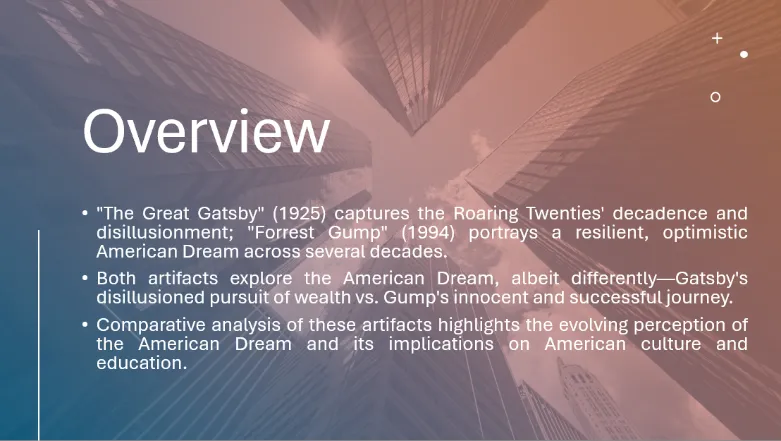
Slide 03
Here, I will discuss how “The Great Gatsby” and “Forrest Gump” depict the American Dream, influencing our understanding of success and societal values. “Gatsby” shows the corruption of the dream in the 1920s, while “Gump” presents a more optimistic view, suggesting that the dream is achievable for all. This analysis helps us appreciate how historical perspectives can inform contemporary discussions on equality and ambition.
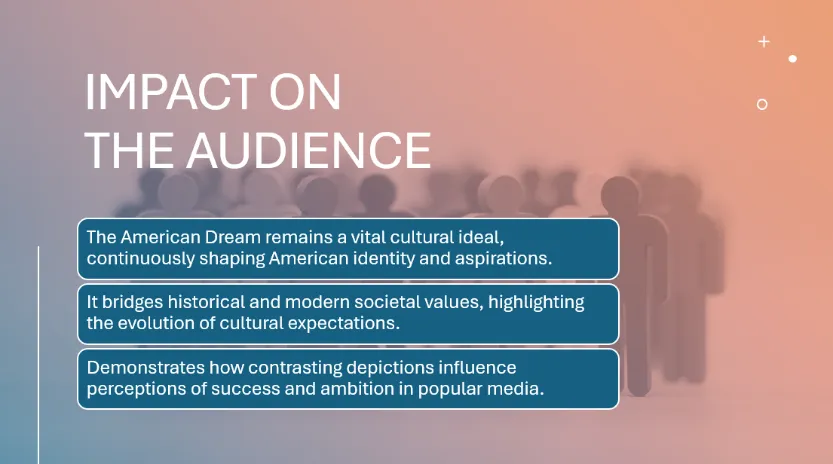
Slide 04
I’ll share how “The Great Gatsby” and “Forrest Gump” offer insights into the American Dream, both shaping and reflecting societal values. These examples illustrate the theme’s complexity, showing how it has inspired optimism and highlighted societal challenges, thereby impacting our understanding of American identity across different periods.
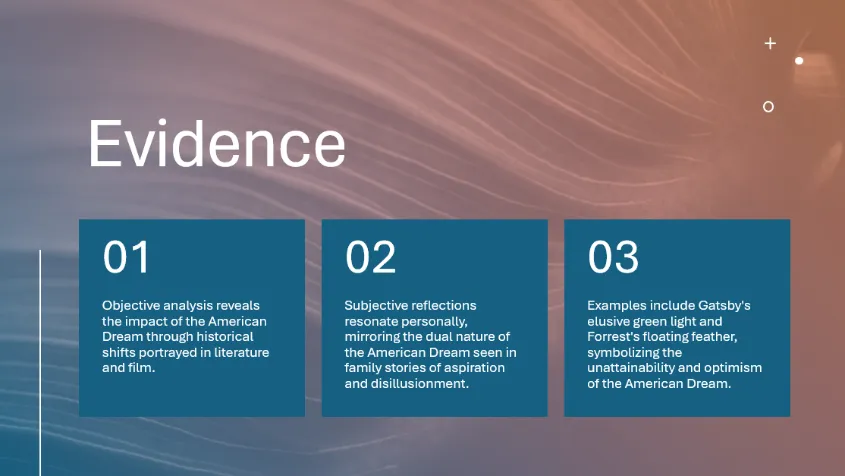
Slide 5
I’ll explain why I selected “The Great Gatsby” and “Forrest Gump” for my project. These stories resonate with me because they reflect the dual aspects of the American Dream that mirror my family’s experiences in America—both the struggles and the successes. This theme’s relevance to both historical and personal contexts deepens my connection to these narratives.
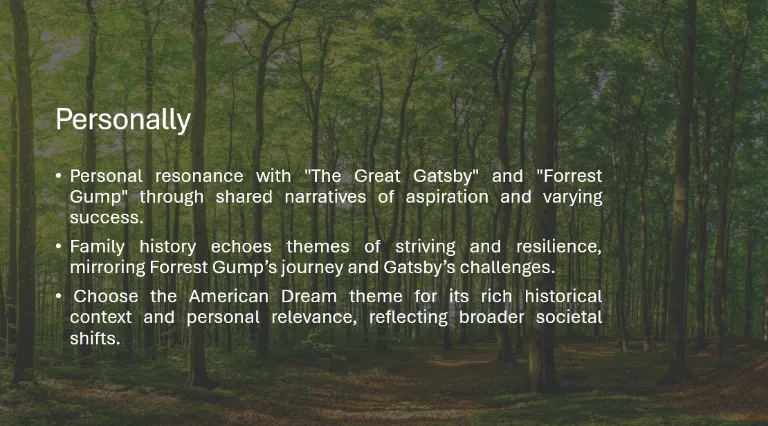
Slide 06
I will discuss how studying the humanities has enriched my personal and professional life. It has sharpened my critical thinking and provided a deeper understanding of different cultures, which is invaluable in any career. This educational path also fosters empathy, helping us navigate our increasingly global society more effectively.
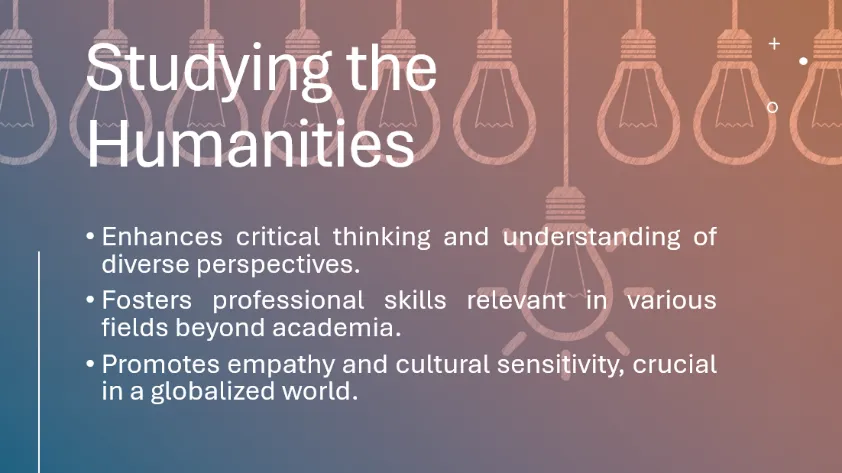
Slide 07
I’ll discuss how the humanities profoundly impact society, illustrated through “The Great Gatsby” and “Forrest Gump.” These studies enhance our understanding of American identity and values, guiding public perceptions and informing policy decisions. They enrich personal perspectives and professional engagements, making a pivotal contribution to societal development.
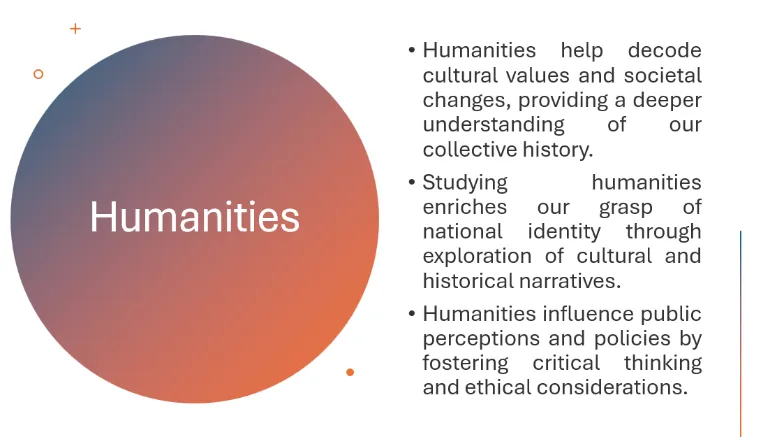
Slide 08
I’ll explain how to tailor our communication to different audiences effectively. This involves adjusting our language complexity, ensuring our content depth is appropriate, and using engagement techniques like questions or multimedia to maintain interest. Our goal is to make our message clear and impactful, leaving the audience with a lasting understanding of our topics.
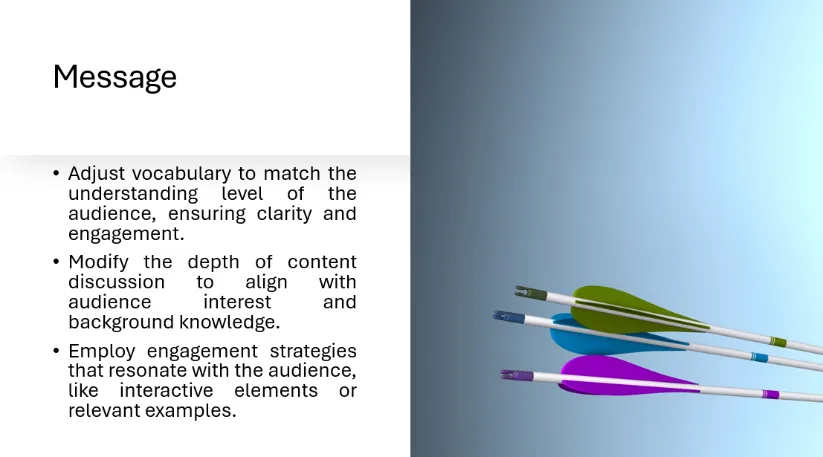
HUM 200 8-1 Discussion: Challenges and Recommendations
Instructions for HUM 200 8-1 Discussion
For this final discussion, post at least one recommendation you have for next term’s humanities students. What approaches did you find helpful in mastering the course concepts?
Respond to peers who suggested strategies that may have also helped you this term, and share why.
For additional details, please refer to the Discussion Rubric PDF document.
Introduction to HUM 200 8-1 Discussion
This last discussion post of HUM 200 revolves around challenges and your recommendations for this respective course. I will provide brief and descriptive guidelines to solve the HUM 200 8-1 Discussion: Challenges and Recommendations, and a dummy solution for each section. This How-To Owlisdom Guide will equip you with guidelines to tackle all the queries related to the HUM 200 8-1 Discussion: Challenges and Recommendations. Let us begin with the guide.
For this final discussion, post at least one recommendation you have for next term’s humanities students.
Formulating Recommendations
We will assess and formulate different recommendations to start the HUM 200 8-1 Discussion: Challenges and Recommendations.
- Based on your reflections, identify one or more critical recommendations for next term’s students. Your advice could range from study habits, engagement with materials, and participation in discussions to utilizing external resources.
- Ensure your recommendations are clear, concise, and based on specific aspects that enhanced your learning experience.
Example
My top recommendation for next term’s humanities students is actively engaging with the course materials and participating in class discussions. Throughout this course, diving deep into the readings, not just skimming through them, and bringing my thoughts and questions to class discussions significantly enriched my understanding and appreciation of the humanities. It’s not only about digesting the content but also about connecting with it on a personal level and sharing those insights with peers. This approach fosters a more profound comprehension of complex concepts and encourages a collaborative learning environment. Remember, the humanities are about exploring human experiences; your unique perspective is invaluable.
What approaches did you find helpful in mastering the course concepts?
Sharing Helpful Approaches
Next, we will share some helpful approaches.
- Elaborate on the approaches you found most beneficial. For example, if engaging with primary source materials deepened your understanding, suggest future students prioritize these resources.
- Active participation should be recommended if participating in group discussions helps clarify complex concepts. Provide practical tips on how to implement these strategies effectively.
Example
One practical approach I discovered in mastering course concepts was the in-depth engagement with primary source materials. I gained firsthand insights into the contexts and nuances of different periods and thought streams by directly interacting with original texts, artworks, and historical documents. This hands-on engagement brought abstract concepts to life, enabling a deeper understanding. Additionally, active participation in group discussions was invaluable. Sharing perspectives and debating interpretations with peers clarified complex ideas and introduced diverse viewpoints. For practical implementation, I recommend creating a study schedule that allocates time for reading and reflecting on primary sources before discussions. This preparation ensures meaningful contributions and maximizes learning from peer interactions. Together, these strategies foster a comprehensive grasp of humanities subjects.
Respond to peers, suggesting strategies that may have helped you this term, and share why.
Peer Responses
Responding to peers is one of the vital parts of the HUM 200 8-1 Discussion: Challenges and Recommendations. We need to provide at least two peer responses. I will provide one example post. You can write your peer responses by keeping the following points in mind.
- Engage with Curiosity and Openness: When responding to peers, express genuine interest in their strategies. Acknowledge the value of their suggestions while sharing your perspective.
- Share Your Experience: If a peer suggests a strategy that worked for you, affirm its effectiveness. Briefly share how it contributed to your success in the course, adding to the recommendation’s credibility.
- Maintain a Professional and Clear Tone: Ensure your responses are thoughtful and articulate. This fosters a constructive dialogue and supports a learning environment where diverse strategies are valued and considered.
Response 01
I appreciated your strategy of engaging deeply with primary sources and found it equally beneficial in my studies. Diving into original texts not only enriched my understanding but also helped me develop a more nuanced perspective on the materials. Your emphasis on preparation for group discussions resonated with me as well. Allocating time to reflect on the readings beforehand maximized the value I got from our exchanges, fostering a more vibrant and insightful dialogue. This approach has undeniably contributed to my success in the course, enhancing both my comprehension and appreciation of the humanities. Your suggestions have been a cornerstone of my learning experience this term.
Closing
This How-To Owlisdom Guide allows you to understand the critical challenges and recommendations for the course of HUM 200. Following the guidelines, you can solve HUM 200 8-1 Discussion: Challenges and Recommendations like a pro. Good luck!
HUM 200 8-5 Project Part Two: Presentation
Instructions for HUM 200 8-5 Project Part Two
Specifically, the following critical elements must be addressed:
I.
Provide a brief overview of your artifacts, theme, and thesis statement. How are they situated within the domain of
the humanities?
II. Explain how the theme, as expressed in the cultural artifacts, and
the thesis statement impact the audience. In other words, how is the theme relevant?
to members of the
audience? Why should the audience care about your thesis statement? Support your response with specific examples
from your
exploration document.
III. Describe the evidence from subjective and
objective cultural analyses that you have to support your conclusions about the impact of the theme
and
cultural artifacts on you personally and on your audience. Support your response with specific examples
from your exploration document.
IV. Explain why the theme and cultural artifacts are
important to you personally. In other words, why did you select these artifacts to study? Why did you
select
your theme, especially if there are other themes that could apply.
V. Explain how
studying the humanities can give you both a personal and professional advantage. In other words, what is the benefit
of studying the
humanities?
VI. Explain why the humanities are important to
society. In other words, what do the humanities tell us about our own culture and experiences? How do
Does the
humanities impact us? Support your response with specific examples from your exploration document and your own
personal and professional
experiences.
VII. Communicate your message in a way that
is tailored to your specific audience. For instance, you could consider your vocabulary, your
audience’s
potential current humanities knowledge or lack thereof, and what is specifically important to
the audience.
Introduction to HUM 200 8-5 Project Part Two
In the HUM 200 8-5 Project Part Two: Presentation, we will review the HUM 200 8-5 Project Part Two: Presentation. I have mentioned detailed guidelines for each part of Project Two in the 7-3 How-To HUM 200 Guide.
I will provide instructions and supporting details to avail maximum value points here.
- After submitting the HUM 200 7-3 Rough Draft, modify your solution according to the Rubric Criteria. If your instructor marks any corrections or highlights any point in your solution, make sure to make changes according to the requirements of the Rubric.
For example, you can see that the title slide in HUM 200 7-3 Draft is quite unprofessional and does not reflect the topic of the Presentation. I will modify the title slide by adding the subject of the presentation to score maximum points.
Example
Old Slide
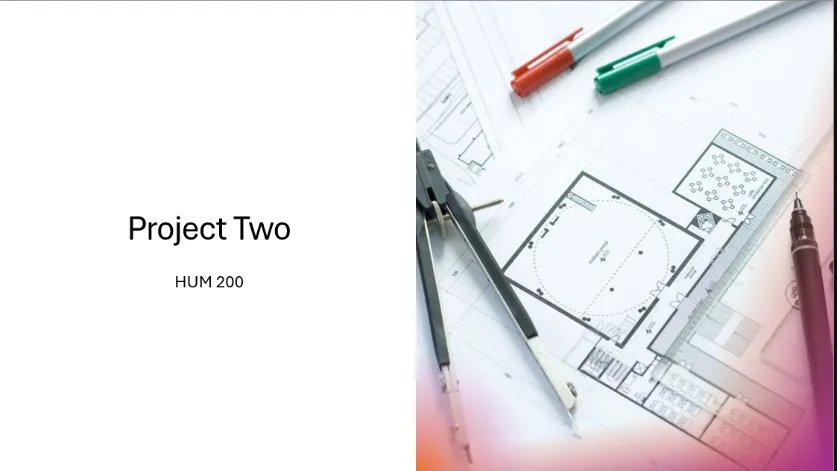
New Slide
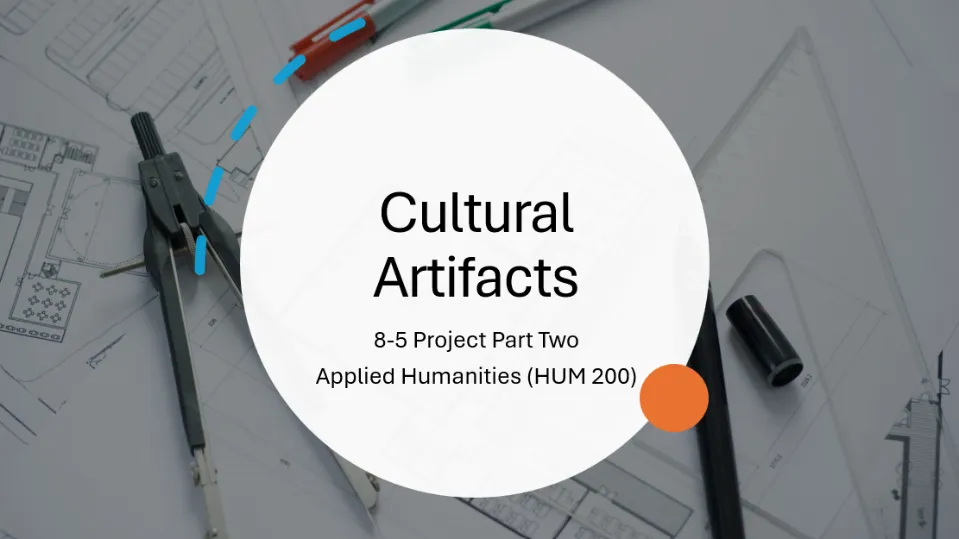
- After making changes and modifications, ensure that the Reference List follows the required format. In the instructions provided by SNHU for HUM 200 Project Part Two, we are asked to use APA format for references. Thus, I have modified the cited sources accordingly.
Example of APA Reference Format
Old Format
LACEB, R. (2018). F. Scott Fitzgerald’s The Great Gatsby (1925): Variations on Forms and Themes. Université Mouloud Mammeri.
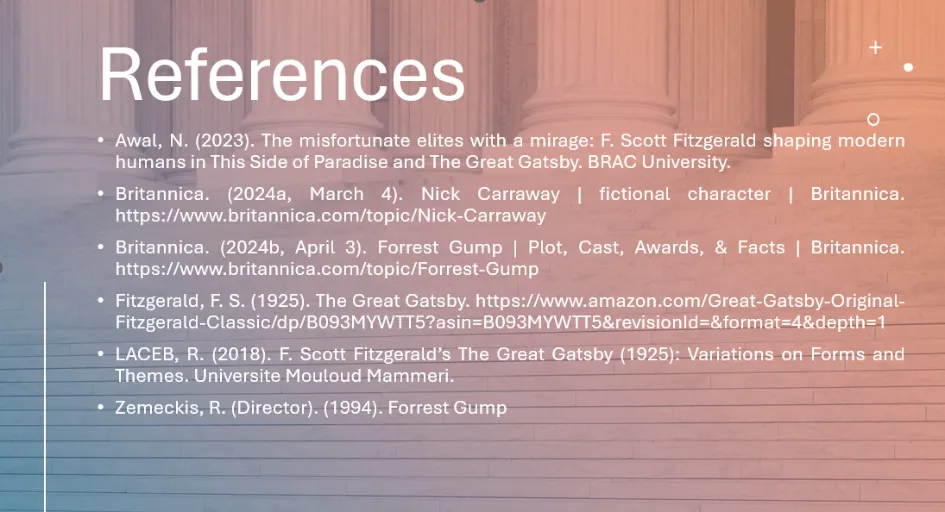
Modified and Correct Format
LACEB, R. (2018). F. Scott Fitzgerald’s The Great Gatsby (1925): Variations on Forms and Themes. Université Mouloud Mammeri.
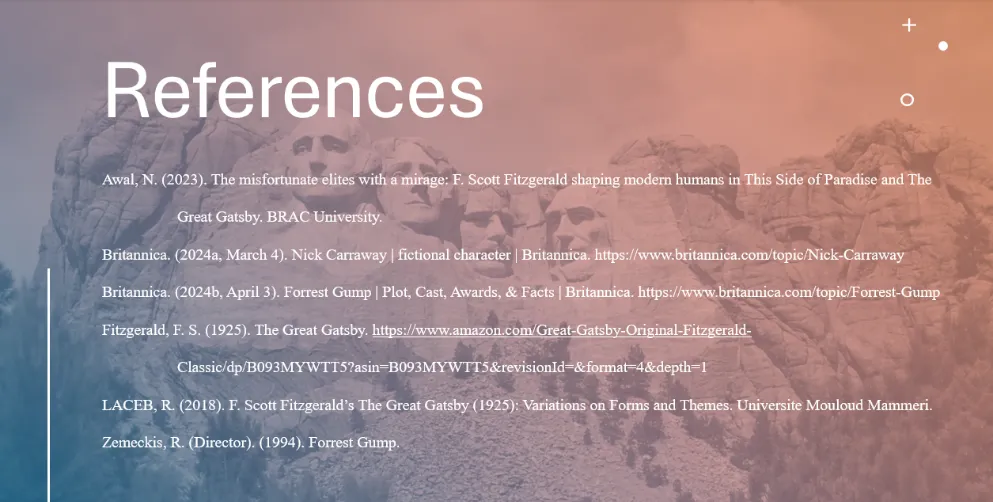
CLOSING
By following this How-To Owlisdom Guide, you will be able to correct your previous mistakes in HUM 200 8-5 Project Part Two: Presentation. Make sure to read your documents and the Rubric carefully to score maximum points.



